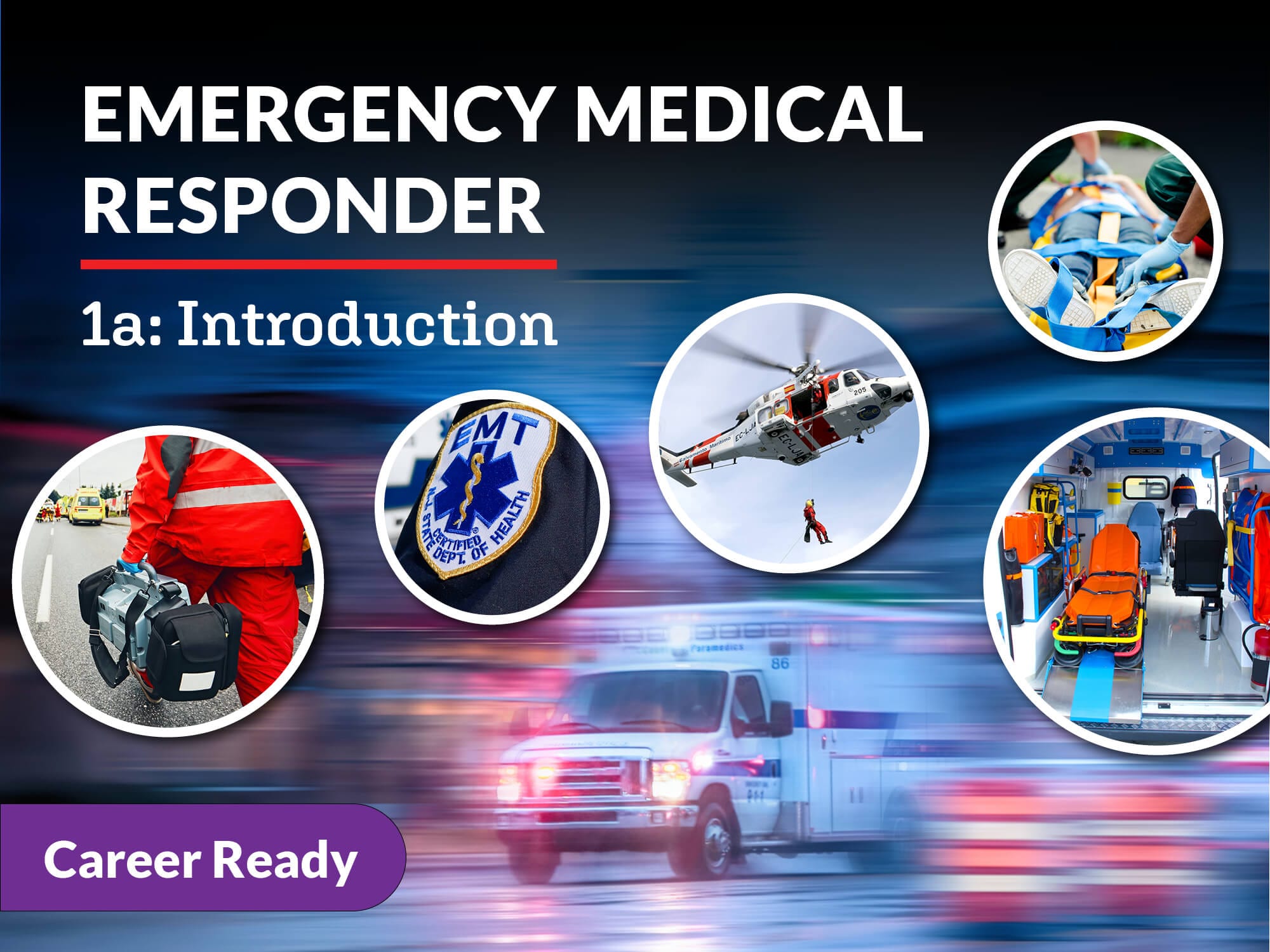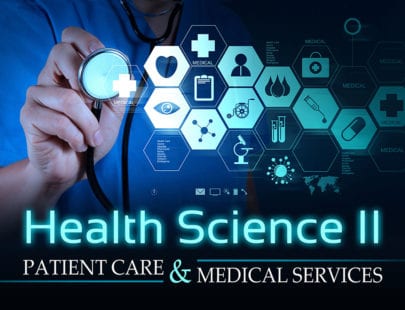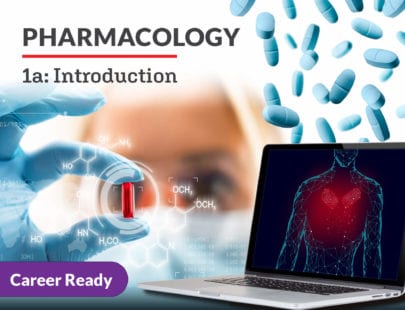
Emergency Medical Responder 1a: Introduction
Have you ever wondered what happens after making a 911 call? Get a realistic look into the day-to-day, fast-paced life of an EMR and how their roles and responsibilities fit into the larger picture with Emergency Medical Services. Discover how to conduct a patient assessment when you arrive on a scene and assess and treat various medical emergencies. If you’ve ever dreamt of being on the front lines, providing quality care to save someone’s life, then explore the exciting career as an Emergency Medical Responder.
Units at a Glance
Unit 1: Emergency Medical Systems
Often, a critical part of health care occurs before a patient even enters a hospital. Together, we’ll discover the exciting world of prehospital emergency medical care and learn the structure of the emergency medical system. You’ll quickly see how you as an emergency medical responder can play a vital role in providing care to patients. In addition, you’ll learn about the responsibilities you will hold as a professional medical responder as well as the necessary ethical and legal considerations. Finally, you’ll gain an understanding of how to handle stressful situations you may face and learn self-protective measures that are critical to your own safety.
What will you learn in this unit?
- Explain the operations of emergency medical systems
- Describe the roles and responsibilities of emergency medical responders
- Identify relevant ethical and legal considerations
- Manage stressful situations
- Protect yourself from infection and disease
- Demonstrate effective communication and leadership skills
Unit 2: Primary Assessment
Emergency Medical Responders are often the first on the scene. Having a standardized approach to assessing both the scene and patient helps provide structure and clarity to often chaotic incidents. Here, we’ll cover patient assessment techniques, including the first stages of the patient assessment plan, and learn how to determine whether the patient requires immediate transport. Get ready – there’s a lot to cover!
What will you learn in this unit?
- Assess an emergency incident patient and scene
- Gather a general impression and determine the level of consciousness
- Monitor airway, breathing, and circulation as well as perform a rapid body survey
- Describe effective patient positioning
- Update EMS and describe transport decision-making
Unit 3: Secondary Assessment
The primary assessment helps you identify, form a general impression of, and deal with any life- or limb-threatening injuries. But what comes next? During the secondary assessment, you become a kind of medical detective, uncovering gaps in your understanding of the patient’s condition. You dig more deeply and ask questions, building on your initial patient assessment. You obtain a detailed patient history, assess pain, take vital signs, and complete a head-to-toe examination. This systematic approach used on each patient will help make you more efficient and effective as a medical responder. You will also learn techniques to clearly record and report your findings to lay a solid foundation for the care the patient will receive from EMS and hospital staff.
What will you learn in this unit?
- Obtain a complete patient history
- Assess a patient’s pain
- Take and analyze vital signs
- Complete a head-to-toe examination
- Record and report your findings
Unit 4: Airway Management
As an EMR, you will be called upon to respond to and manage life threats. We will teach you the interventions needed to preserve life. Assessment and management of a patient’s airway and breathing are two of the most time-critical, life-saving measures you can take. You’ll learn how to assess breathing in more detail; open and secure an airway; suction an airway and clear debris; and use oxygen therapy and ventilation devices.
What will you learn in this unit?
- Assess a patient’s airway and breathing comprehensively
- Open and secure an airway
- Suction and clear an airway
- Supply oxygen to a patient
- Ventilate a non-breathing patient
Unit 5: Cardiac and Respiratory Emergencies
The fastest-paced calls an EMR will respond to are for patients in cardiac or respiratory emergencies. When a patient can’t breathe or their heart isn’t functioning properly, their life is in the balance. As an EMR, you can make a significant difference in patients’ outcomes during respiratory and cardiac emergencies. Here, we’ll look at how to identify respiratory as well as cardiac illnesses and respond to emergencies, including heart attacks and choking. What you learn could save a life!
What will you learn in this unit?
- Identify common respiratory and cardiac illnesses
- Intervene in respiratory and cardiac emergencies
- Perform CPR with an AED during a cardiac arrest emergency
- Assist with airway obstructions and choking emergencies
Unit 6: Medical Emergencies
Delve into the world of medical detective work by investigating the reasons your patient isn’t acting normally or is unconscious. Here, you will learn about the causes of altered mental states and some of the more common reasons behind abdominal discomfort. When you know what signs to look for, you can more quickly assess the possible issue affecting your patient. Considering the treatments available for each issue will give you a path to follow as you handle the emergency.
What will you learn in this unit?
- Consider different causes for a patient to have altered levels of consciousness
- Understand the causes and types of diabetes
- Assess a patient with a suspected stroke
- Manage a patient having a seizure
- Investigate the causes of abdominal pain
Unit 7: Trauma Management
Broken bones and bleeding might be the stuff of movies, but they are also the realities of many incidents requiring the dispatch of an EMR. You will need to assess and treat patients both rapidly and decisively to prevent further injury or death. Trauma management can be high-adrenaline and graphic. Still, it is rewarding to see your efforts make a difference right before your eyes.
What will you learn in this unit?
- Understand the causes and types of shock
- Treat wounds and other soft tissue injuries
- Manage major bleeds and burns
- Assess and treat sprains, strains, dislocations, and fractures
- Manage spinal injuries
Unit 8: Other Medical Emergencies
Our body systems can be doing their jobs on the inside to keep us going when our health is suddenly threatened by things or conditions in the external environment. Poisons that make their way into the body can cause serious harm, including those obtained from bites, stings, and drug overdoses. Let’s dig further into how allergies affect the body and what happens when an allergic reaction becomes life-threatening. Extreme temperatures can also impact the body’s ability to function, so learning about the different heat- and cold-related emergencies patients may face can help you provide the best care possible.
What will you learn in this unit?
- Understand the routes and types of poisons
- Respond to emergencies in which a patient has had an overdose or has been poisoned, bitten, or stung
- Identify when an allergic reaction becomes a life-or-death situation
- Recognize as well as treat heat- and cold-related emergencies
- Be familiar with medications that emergency medical responders might administer
Required Materials
Physical
- Computer
- Digital camera device or video recorder
- Large pen or marker
Software
- Internet access
- Word processing software
Other
- Friends or family members
Optional
- Pencil (optional)
- Paper (optional)



